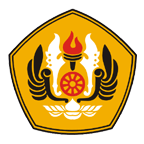Molecular Docking Studies of Compounds from Brucea javanica (L.) Merr. Towards The Discovery of Potential H5N1 Neuraminidase Inhibitors
Abstrak
The occurrences of a highly pathogenic avian influenza virus (HPAI) type A H5N1 has caused infections in millions of poultry as well as hundreds of human cases and even mortalities. Indonesia has become one of the world’s highest casualty rates of H5N1 human infections, with the number of deaths was 167 from a total of 199 cases. The development of viral resistance towards the available anti-influenza drugs neuraminidase (NA) inhibitors required the discovery of new inhibitors. In the recent advance of drug discovery, natural products have been considered as one of the essential sources of medicinal agents, and Brucea javanica has been found to possess antiviral activity against H5N1 NA. Thus, this research aimed to investigate the in silico activities of compounds from B. javanica using molecular docking methods against H5N1 NA. In this study, docking-based virtual screening of compounds from B. javanica to quickly select in silico hits to be potential NA inhibitors was performed. Subsequently, the intermolecular interactions of the inhibitor compounds with the H5N1 NA were analysed to examine the most preferred interactions. The results showed that brucein G and bruceoside C were found having the lowest binding energy and most preferred interactions with H5N1 NA and therefore, can be proposed for further study as potential NA inhibitors.
Keyword: antiviral, Brucea javanica, H5N1, molecular docking, neuraminidase
Teks Lengkap:
PDF (English)Referensi
Wonderlich ER, Swan ZD, Bissel SJ, Hartman AL, Carney JP, O'Malley KJ, et al. Widespread Virus Replication in Alveoli Drives Acute Respiratory Distress Syndrome in Aerosolized H5N1 Influenza Infection of Macaques. J Immunol. 2017;198(4):1616-26.
Smetana J, Chlibek R, Shaw J, Splino M, Prymula R. Influenza vaccination in the elderly. Human Vaccines & Immunotherapeutics. 2018;14(3):540-9.
WHO. Cumulative number of confirmed human cases for avian influenza
A(H5N1) reported to WHO, 2003-2019 2019 [updated 25 November 2019. Available from: https://www.who.int/influenza/human_animal_interface/2019_11_25_tableH5N1.pdf?ua=1.
Uyeki TM, Peiris M. Novel Avian Influenza A Virus Infections of Humans. Infect Dis Clin North Am. 2019;33(4):907-32.
CDC. Highly Pathogenic Asian Avian Influenza A (H5N1) in People 2015 [updated 18 March 2015. Available from: https://www.cdc.gov/flu/avianflu/h5n1-people.htm.
Welkers MRA, Pawestri HA, Fonville JM, Sampurno OD, Pater M, Holwerda M, et al. Genetic diversity and host adaptation of avian H5N1 influenza viruses during human infection. Emerging Microbes & Infections. 2019;8(1):262-71.
Mangiri A, Iuliano AD, Wahyuningrum Y, Praptiningsih CY, Lafond KE, Storms AD, et al. Physician's knowledge, attitudes, and practices regarding seasonal influenza, pandemic influenza, and highly pathogenic avian influenza A (H5N1) virus infections of humans in Indonesia. Influenza and Other Respiratory Viruses. 2017;11(1):93-9.
McKimm-Breschkin JL. Influenza neuraminidase inhibitors: antiviral action and mechanisms of resistance. Influenza Other Respir Viruses. 2013;7 Suppl 1:25-36.
Gubareva LV, Kaiser L, Hayden FG. Influenza virus neuraminidase inhibitors. Lancet. 2000;355(9206):827-35.
Vavricka CJ, Li Q, Wu Y, Qi J, Wang M, Liu Y, et al. Structural and functional analysis of laninamivir and its octanoate prodrug reveals group specific mechanisms for influenza NA inhibition. PLoS Pathog. 2011;7(10):e1002249.
Samson M, Pizzorno A, Abed Y, Boivin G. Influenza virus resistance to neuraminidase inhibitors. Antiviral Res. 2013;98(2):174-85.
Kannan S, Kolandaivel P. Antiviral potential of natural compounds against influenza virus hemagglutinin. Comput Biol Chem. 2017;71:207-18.
Gasparini R, Amicizia D, Lai PL, Bragazzi NL, Panatto D. Compounds with anti-influenza activity: present and future of strategies for the optimal treatment and management of influenza. Part II: Future compounds against influenza virus. J Prev Med Hyg. 2014;55(4):109-29.
Purwitasari N. Aktivitas Antiviral Influenza A Subtipe H5N1dari Ekstrak Brucea javanica L.Merr. Planta Husada. 2014;2(2):27-30.
Ikram NKK, Durrant JD, Muchtaridi M, Zalaludin AS, Purwitasari N, Mohamed N, et al. A Virtual Screening Approach For Identifying Plants with Anti H5N1 Neuraminidase Activity. Journal of Chemical Information and Modeling. 2015;55(2):308-16.
Ye Q-M, Bai L-L, Hu S-Z, Tian H-Y, Ruan L-J, Tan Y-F, et al. Isolation, chemotaxonomic significance and cytotoxic effects of quassinoids from Brucea javanica. Fitoterapia. 2015;105:66-72.
Chen YY, Pan QD, Li DP, Liu JL, Wen YX, Huang YL, et al. New pregnane glycosides from Brucea javanica and their antifeedant activity. Chem Biodivers. 2011;8(3):460-6.
Liu JH, Jin HZ, Zhang WD, Yan SK, H. SY. Chemical constituents of plants from the genus Brucea. Chemistry & Biodiversity. 2009;6(1):57-70.
Xiao W, Wang D, Shen Z, Li S, Li H. Multi-Body Interactions in Molecular Docking Program Devised with Key Water Molecules in Protein Binding Sites. Molecules. 2018;23(9).
Gubareva LV, Robinson MJ, Bethell RC, Webster RG. Catalytic and framework mutations in the neuraminidase active site of influenza viruses that are resistant to 4-guanidino-Neu5Ac2en. J Virol. 1997;71(5):3385-90.
DOI: https://doi.org/10.24198/ijpst.v7i1.25643
Refbacks
- Saat ini tidak ada refbacks.
| Switch to English Back to Top |
| View My Stats Penerbit Universitas Padjadjaran
Jurnal ini terindeks di :Creative Commons Attribution :
Based on a work at http://jurnal.unpad.ac.id/ijpst/ |
 Indonesian Journal of Pharmaceutical Science and Technology
Indonesian Journal of Pharmaceutical Science and Technology




